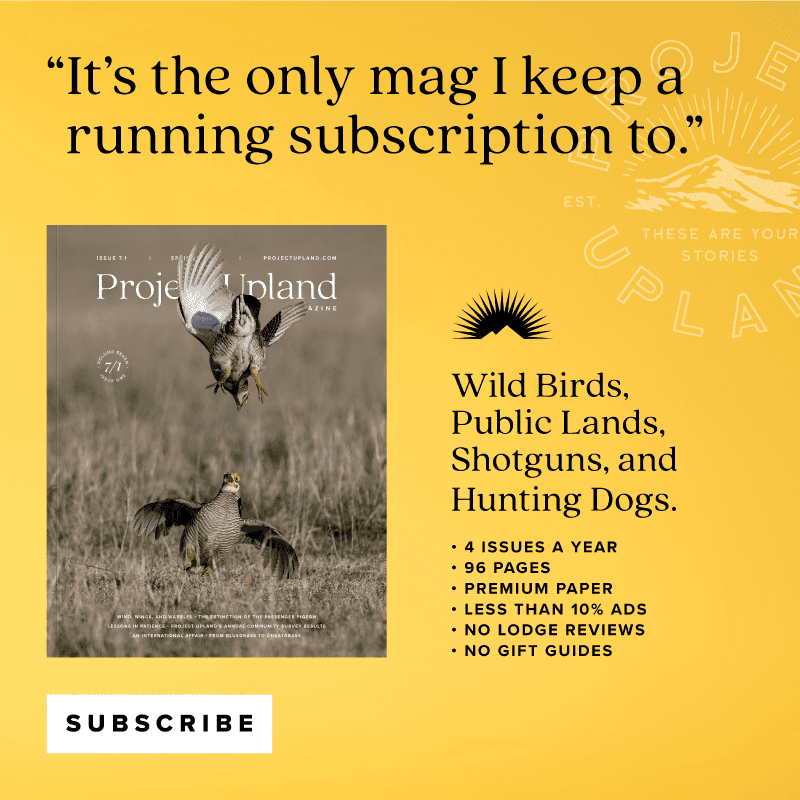Home » Hunting Dogs » Irish Setter: Form, Function, and History of a Timeless Breed
Irish Setter: Form, Function, and History of a Timeless Breed
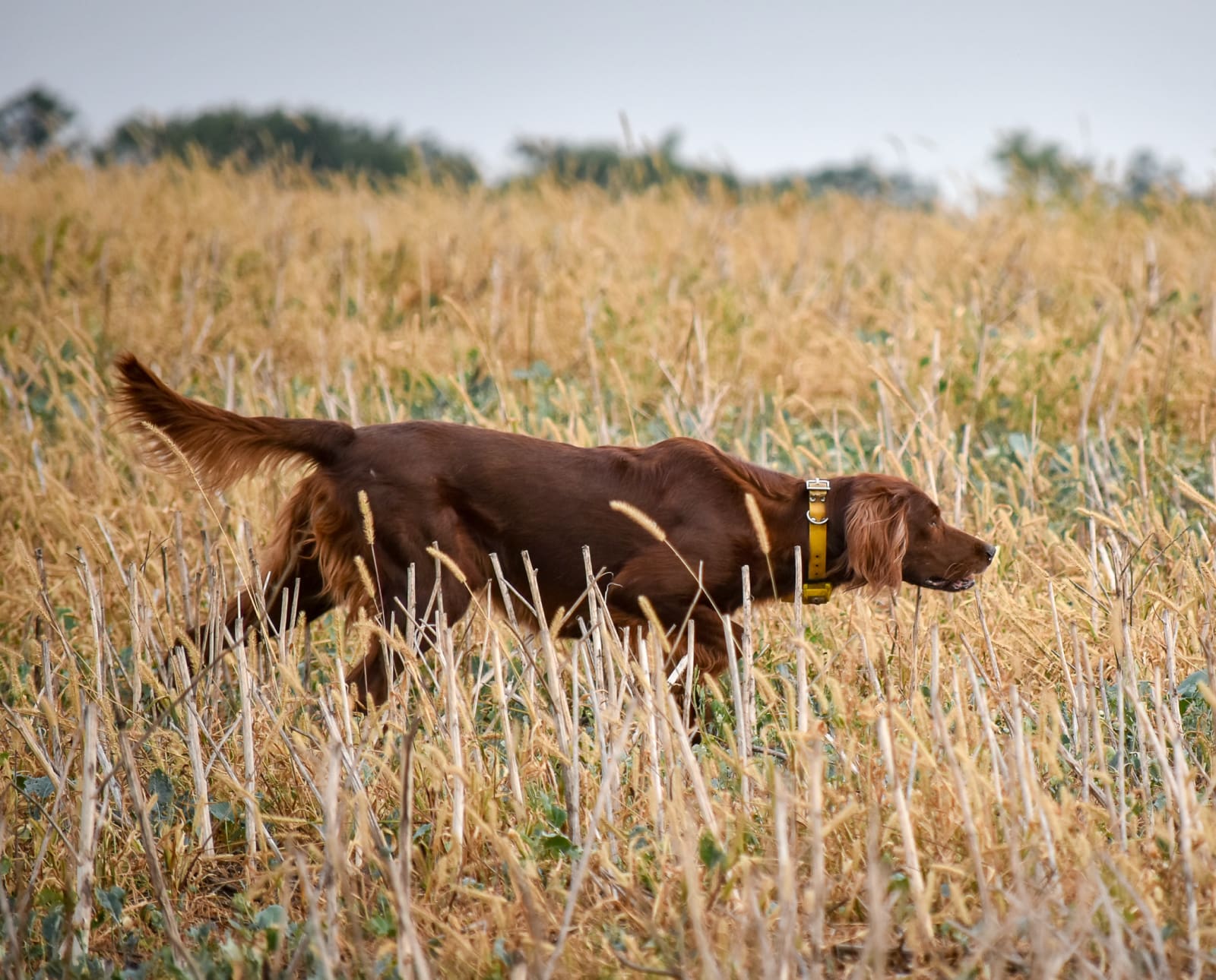
Gabby Zaldumbide is Project Upland's Editor in Chief. Gabby was…
Discover the Irish Setter, an iconic red hunting dog breed renowned for its distinct characteristics and rich history. Learn about its unique form, function, and the role it has played in hunting and companionship.
The long-awaited Pointing Dogs Volume Two: The English and Irish Breeds by Craig Koshyk has finally hit shelves. Inside, readers can explore in-depth information about Pointers, setters, and the overall development of bird dogs across the pond. Koshyk features an entire chapter about Irish Red Setters alone; let’s take a peek inside.
Listen to more articles on Apple | Google | Spotify | Audible
It’s believed that Irish Setters are perhaps the oldest breed of setting dogs. “The spaniels that became setting dogs were in Ireland since at least the 16th century,” said Koshyk. It’s easy to imagine this gorgeous dog breed loping across vibrantly green hillsides in search of game, regardless of whether it’s in the 16th century or the 21st.
If you get the chance to meet, hunt with, or own an Irish Setter someday, you’ll be amazed by their athleticism, drive, and happy-go-lucky personality. Walter Baxendale, kennel editor for The Field and the writer of “Dog” in 1911’s 11th edition of Encyclopedia Britannica, certainly thought so. “No one who has ever seen Irish Setters move in a field can ever again mistake one of these for a dog of any other breed,” he said.
Irish Setter Characteristics and Form
| Characteristics | Details |
| Name | In Ireland and the FCI: Irish Red Setter UKC, AKC, CKC, and American field trailers and hunters: Irish Setter The Field Dog Stud Book: Red Setters |
| Size | Medium, 45-65 pounds Males: 60 cm, Females: 55 cm |
| Tail | Fabulous, not docked |
| Coat | Longer and thicker on show dogs, thinner and shorter on hunting dogs |
| Coat Color | Solid red, chestnut, or mahogany |
| Health Issues | Hip dysplasia, gastric dilatation (bloat), epilepsy, cancer, progressive retinal atrophy, degenerative myelopathy, canine leukocyte adhesion deficiency, and Von Willebrand’s disease. |
| Character | Happy with a strong desire to please |
| Population | 1,500+ bred each year globally |
| Range | Wide-ranging |
| Pace | Fast |
| Good Choice For | Grouse, woodcock, pheasant, quail, ptarmigan, chukar, waterfowl |
Irish Setters are the epitome of a medium-sized dog. They tend to be about 22 inches tall at the shoulder and weigh between 45 and 65 pounds. This weight is distributed evenly throughout their athletic frame, giving off the appearance of a fluid, graceful dog. Having a beautiful, flowing coat helps with this image, too.
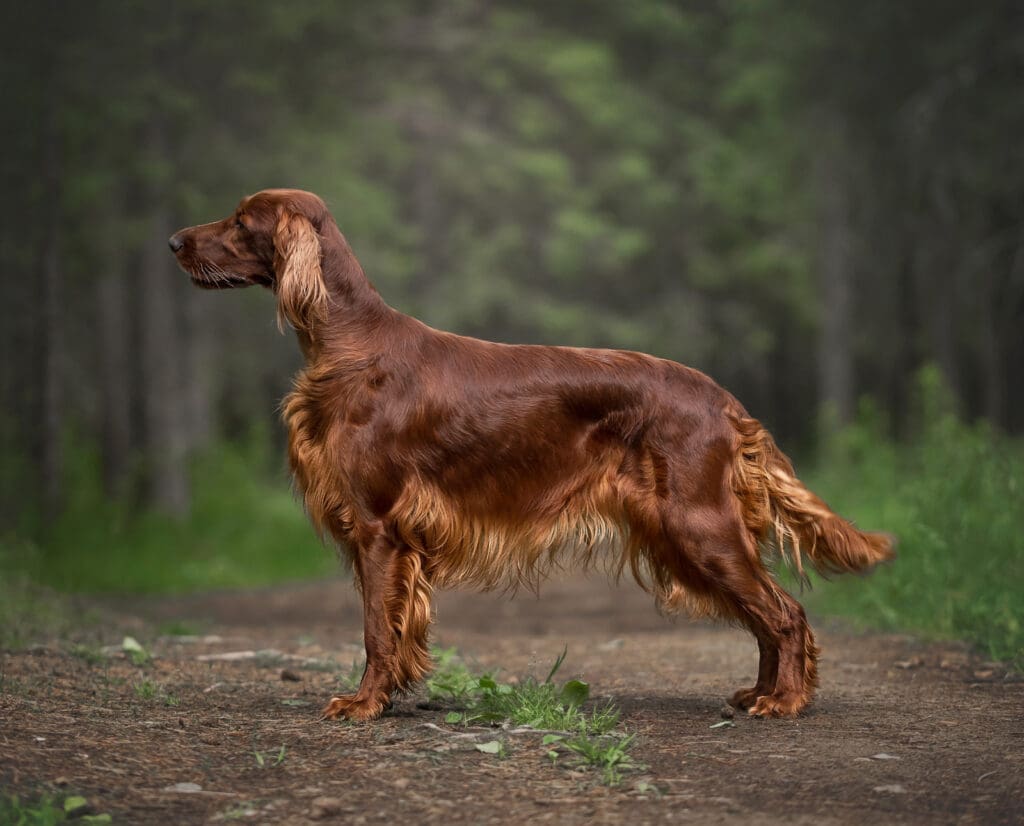
There is some coat variance between Irish Setters bred for the show ring and those bred for hunting purposes. Show dogs tend to have a thicker, longer, more mahogany-colored coat. Conversely, hunting dogs generally have thinner, shorter, and more chestnut-colored coats. It’s believed that the thin, short coat on hunting dogs helps with thermoregulation and avoiding burrs and awns. “If we are to accept that the Irish Red Setter is primarily a gundog then an overabundance of hair must be considered a fault,” said Raymond O’Dwyer, a president of the Irish Setter Club of Ireland in the 1980s.
Regardless of the length and thickness, some folks are incredibly passionate about exactly what color an Irish Setter is. A man named Idstone poetically describes the color as a “chestnut thoroughbred on a May morning in the sun.” No matter what shade of red your setter happens to be, it’s undoubtedly a magnificent color.
Irish Setter Training and Hunting Ability
How training your Irish Setter goes varies depending on their personality. Some argue that these dogs are hard-headed and wild; others claim that Irish Setters are very soft and easily ruined. During Koshyks’ time researching this breed, he realized that these claims “are probably based in a fundamental misunderstanding of the breed.” Koshyk believes that O’Dwyer got it right when he said, “Irish Setters work best for those with whom they have a bond. In this relationship, they are prepared to give more than they receive, but if there is no bond between trainer and dog there will be difficulties.”
Be mentally prepared to spend time bonding with your setter. Doing so will improve your relationship and certainly enhance your dog training sessions and time spent chasing birds. This is especially important if you plan on trying to breed your setter.
“Unlike some breeds that only have a conformation standard, the Irish Red Setter also has a written working standard, ratified and promoted by the parent club in the breed’s native land,” writes Koshyk. The parent club’s working standard must be seen as an authority. Additionally, Koshyk references the US National Red Setter Field Trial Club’s standard when appropriate.
Field Search
According to the Irish parent club, this breed is always a fast, wide-ranging bird dog. These dogs were bred to be partridge and grouse dogs. As a result, they depict intensity, purpose, and concentration in the field. Irish Setters typically gallop when searching for game, holding their head above and tail in line with their horizontal back. A setter’s muzzle stays parallel to the ground as its square body seemingly floats above the earth.
According to the parent club, these dogs should break “their casts as they check the wind for the faintest taint of game. Should it be unfounded they resume their cast with urgency. The depth between the casts should be moderately open, depending on the conditions of the day.” American field trial standards are quite similar, but dogs are not expected to quarter the field in the US. Additionally, US standards state that “depths between casts are dictated by the conditions of the day and the terrain.”
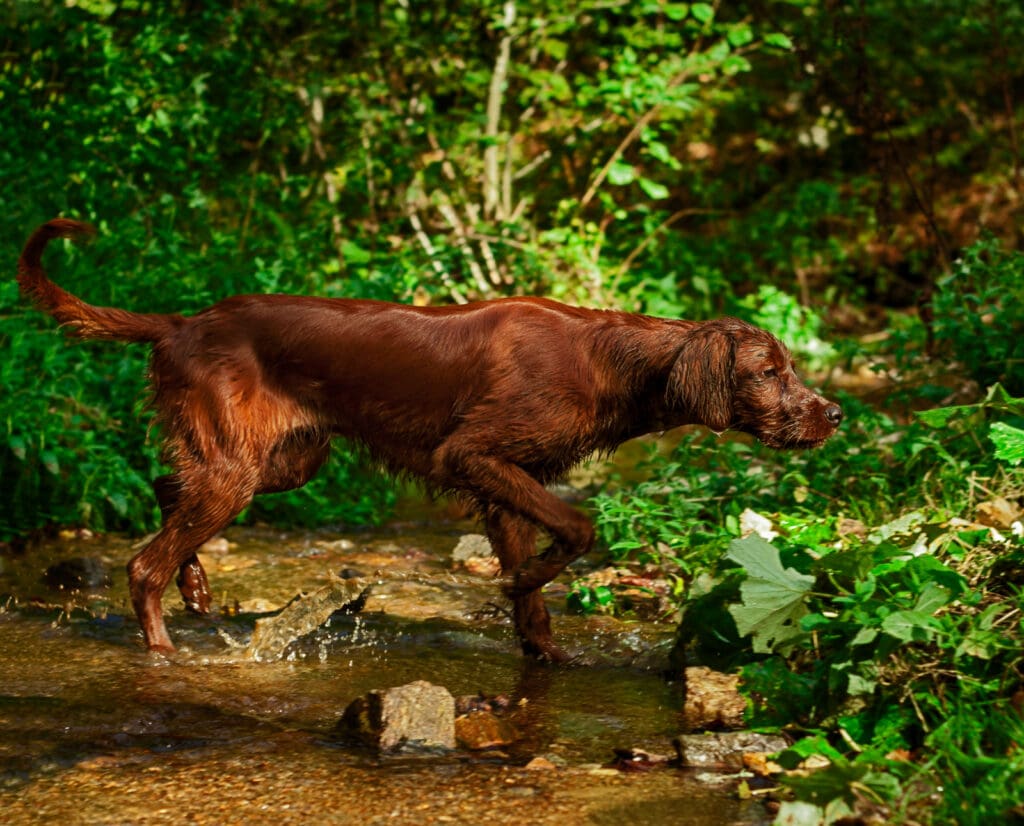
Pointing
In the past, Irish Setters had a reputation for “being a little too free around game,” writes Koshyk. They’d tend to get closer and closer to birds without actually pointing. Thankfully, Hugh Brady, a top-tier trialler, argues that this attribute is a thing of the past.
“Years ago, young dogs would road and road and road, and never really come to a full stop on their birds, and it would take up to three years before many of them would consistently point game,” said Brady in a personal communication with Koshyk. “Nowadays, that has all changed. Many Irish Setters point birds before they are a year old…in fact, nearly all of my dogs have earned their field championship titles before they were 24 months old.”
The Irish Setter’s pointing posture varies between American and Irish standards. According to the Irish standard, this breed should be “standing or crouched…The set is intense and rigid, full of energy and concentration…The head is held well up, eyes fierce, ears high, forward and expressive, the tail rigid, bristling with the passion of the find, arched under its back or in its line.”
Instead of a crouch, the American standard requires Irish Setters to point standing tall. Their head and tail should be held high “due to the fact that in American field trials, all bird dogs are expected to be ‘high on both ends’ when they point,” according to Koshyk.
Irish and American standards also differ when it comes to roading. Roading is “when a dog moves forward after a point, under command, until the birds flush,” says Koshyk. Irish Setters are not expected to road in America, unlike in Ireland and England.
Retrieving
“Irish Setters make excellent retrievers on land and from water; most of them do it naturally, and if you keep them well under control will do no harm, but on the contrary make them keener,” said Colonel Millner, a British breeder and author of The Irish Setter – Its History & Training, in the early 1900s. Today, Koshyk mentions that Colonel Millner’s statement rings true whether you’re on the eastern or western side of the Atlantic. Many Irish, British, and American bird hunters expected their setters to retrieve both in the past and present.
Koshyk’s sources in the United Kingdom, Canada, New Zealand, America, and even Norway have noted the desire to retrieve in their Irish Setters. New Zealand-based Irish Red Setter breeder Robyn Gaskin told Koshyk that the breed has an innate love for retrieving; her dogs are natural retrievers and make fine duck dogs. “In our country, all our setters must retrieve in field trials run on pheasant and quail,” she said.
Koshyk’s friend Graeme Crawford, an avid upland and waterfowl hunter, told him, “Compared to the English Setters I’ve had and even the Gordon Setters I’ve known, my Irish Setters tend to be a bit more versatile. All my English Setters retrieved well but my Irish were more natural waterfowl dogs, with more drive.”
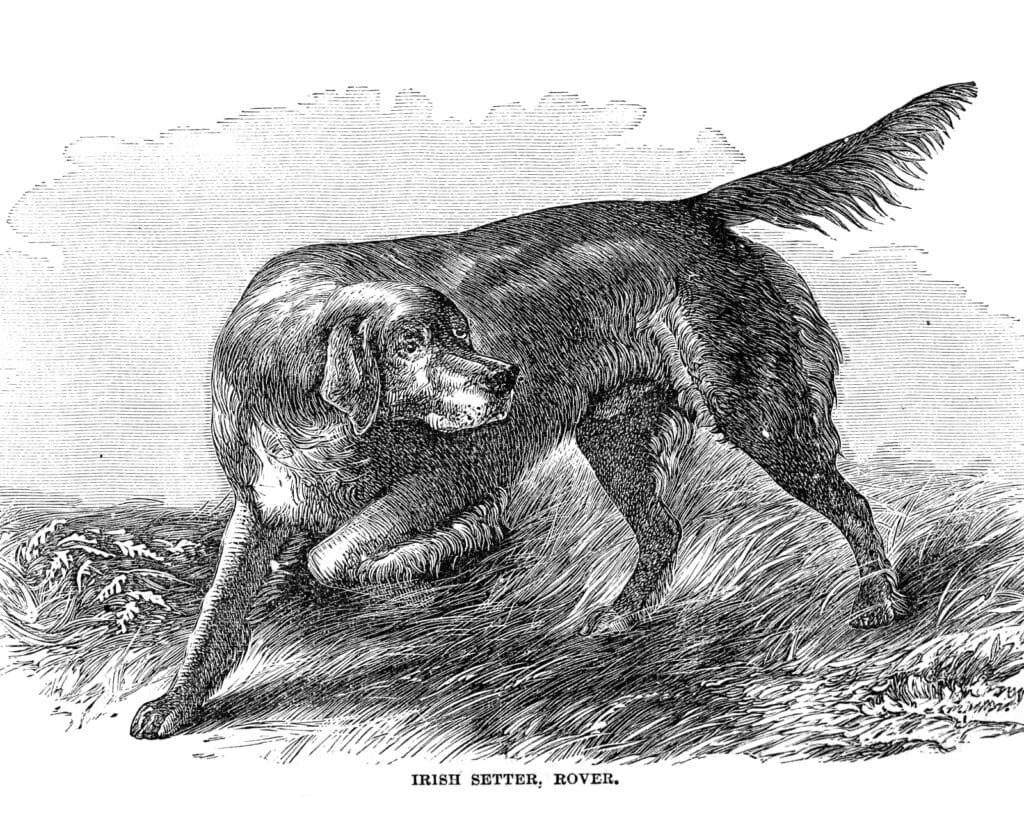
Irish Setter History and Development
The first mentions of setting dogs crossing the English Channel come from English sources. However, given that Ireland and France were closely linked thanks to centuries of migration, it’s possible that Ireland was sending dogs to the European Continent in addition to England. Those English sources show that “red spaniels” were present in Ireland since at least the 16th century.
Back then, these dogs were bred strictly for hunting ability, not looks. Most of the time, dogs had a red-and-white coat or a solid red coat. White-and-red coats were present as well. “The ‘standards’ they followed were determined by the game and terrain they hunted and modified to suit their personal taste,” said Koshyk. “Nevertheless, by 1800 the overall look of the breed was well-enough established that we can easily identify Irish Red Setters in paintings from that era.”
The Irish Rebellion of 1798, the potato famine, and mass emigration affected the breed’s development in the early 1800s. Additionally, from 1840 to 1880, international interest in English Setters and Pointers increased. These socioeconomic and cultural conditions harmed the Irish Setter’s reputation as a gundog. However, by the onset of the 1900s and greater interest in dog shows and field trials, things began to change.
John Nash, the father of the modern Irish Setter, wrote,
“About 1890 a dog called Plunket appeared on the scene…He competed successfully at field trials…He was eventually bought by Mr. Purcell-Llewellin, and formed part of the most unbeatable brace with the famous English Setter Countess…It is recorded by Purcell-Llewellyn that the crossing of Plunket with the Laveracks formed the foundation of what is known today as the show English Setter.”
Koshyk explains that Nash continued to write on this subject and ultimately stated that although “there had always been outstanding individuals in every era, something always seemed to get in the way.” Breeders died or gave up, a war began, or the breed would begin to have health issues. “For every two steps forward, there was one step back.”
Thankfully, in the 1950s, John Nash assembled Irish Setter breeders and enthusiasts to work out a “rational breeding program designed to, once and for all, help the Irish Red Setter claim its rightful place among the best bird dogs on the planet.” As it turns out, their dedicated efforts paid off. “The 1950s produced nine field trial champions, beginning with Blacksmith in 1950. The 1960s produced ten field trial champions, but it was in the 1970s that the breed reached new levels of success with twenty field trial champions,” wrote Irish Setter breeder Hugh Brady.
By the early 2000s, Irish Setters were the top breed in Irish field trials. Today, countries across the world have Irish Setter breed clubs. In fact, 17 of them formed the International Irish Red Setter Club, which is “designed to help ensure a bright future for the breed,” said Koshyk.
“What the future holds for the Irish Red Setter is, of course, unknown,” continued Koshyk. “But in Ireland and an increasing number of other countries, the breed is firmly in the hands of men and women dedicated to maintaining its position as a world-class gundog.”
Irish Setter Clubs
The list of Irish Setter clubs includes:
- Irish Red Setter Club (Ireland)
- Irish Setter Association (England)
- The Irish Setter Club of Scotland Irish Setter Club of America (USA)
- National Red Setter Field Trial Club (USA)
- Irish Setter Club of Canada
- Norskirsksetterklub (Norway)
- Svenska Irländsk Setterklubben (Sweden)
- Irish Setter Club Deutschland e.V. (Germany)
- Dansk Irsk Setter Klub (Denmark)
- lerse Setter Club (Netherlands)
- Le Red Club (France)
- Ierse Setter Club (Belgium)
- Red Setter Club d’Italia (Italy)
- Irish Setter Club (New Zealand)
- International Irish Red Setter Club
Gabby Zaldumbide is Project Upland's Editor in Chief. Gabby was born in Maryland and raised in southern Wisconsin, where she also studied wildlife ecology at the University of Wisconsin-Madison. In 2018, she moved to Gunnison, Colorado to earn her master's in public land management from Western Colorado University. Gabby still lives there today and shares 11 acres with eight dogs, five horses, and three cats. She herds cows for a local rancher on the side.






